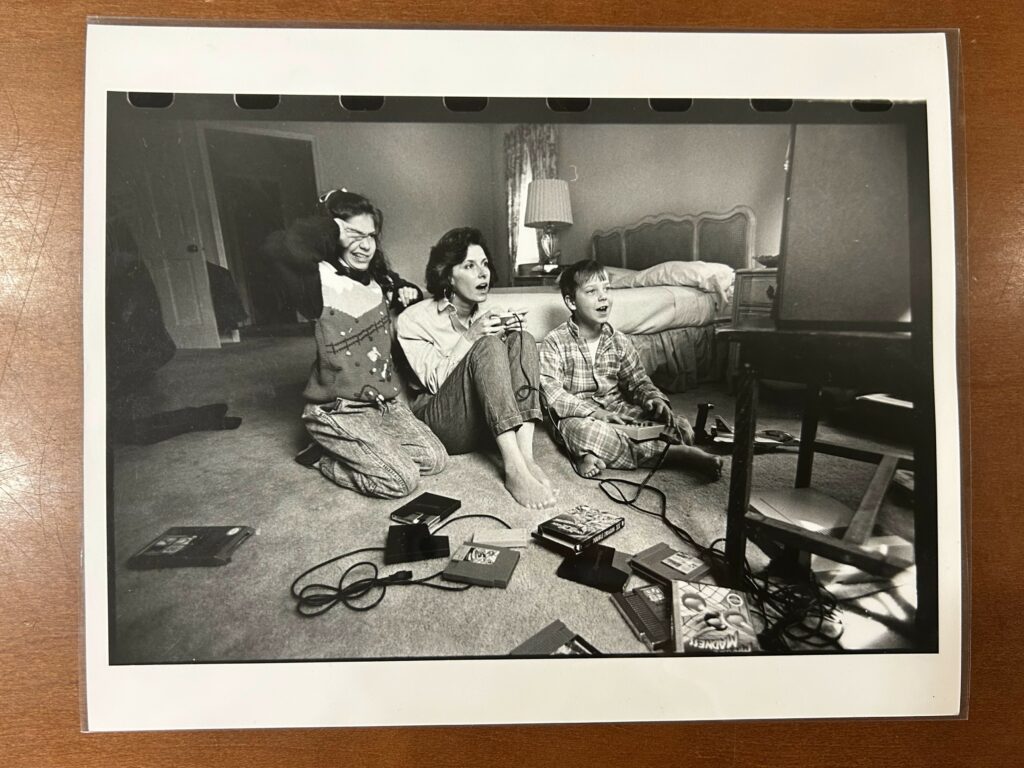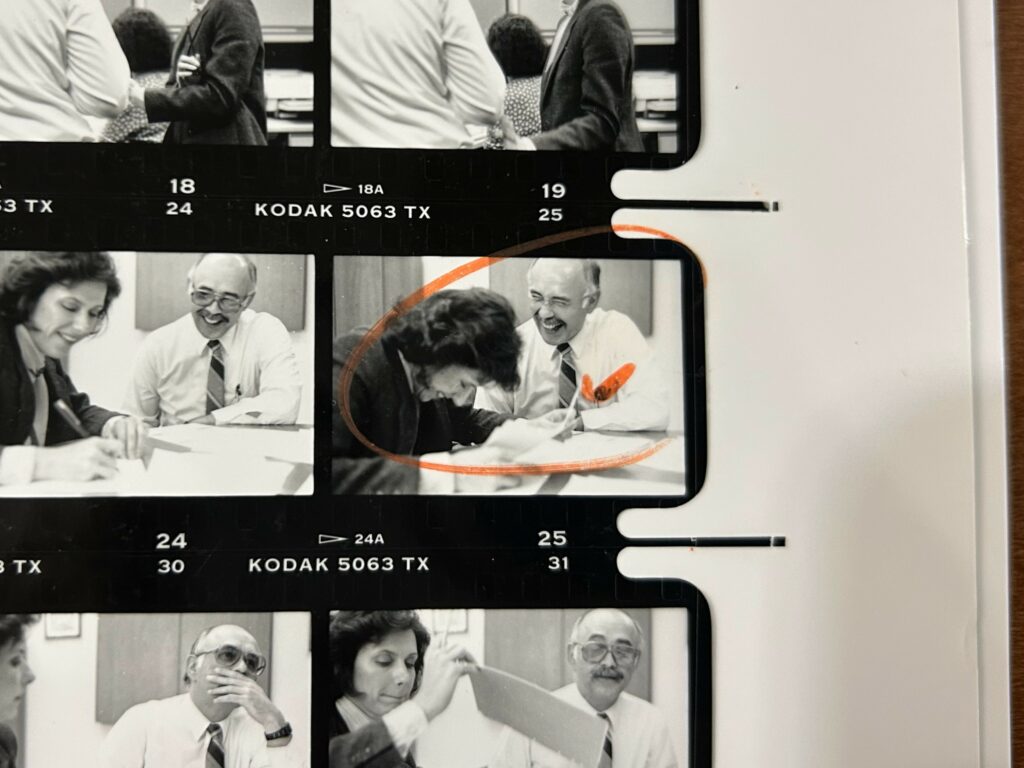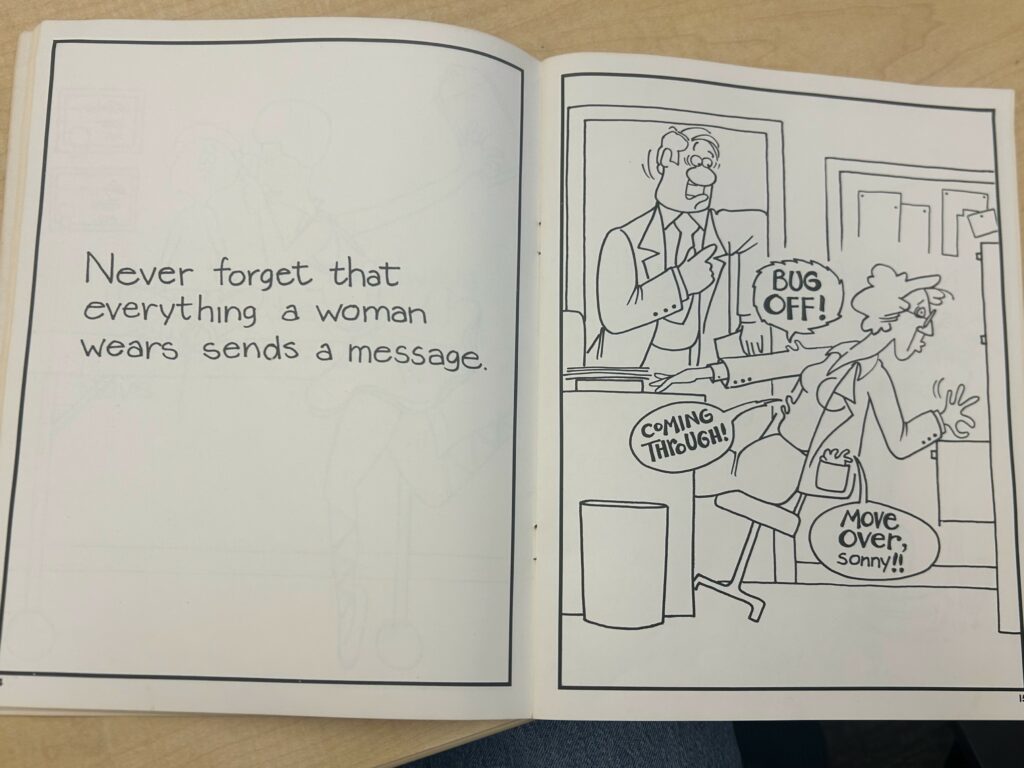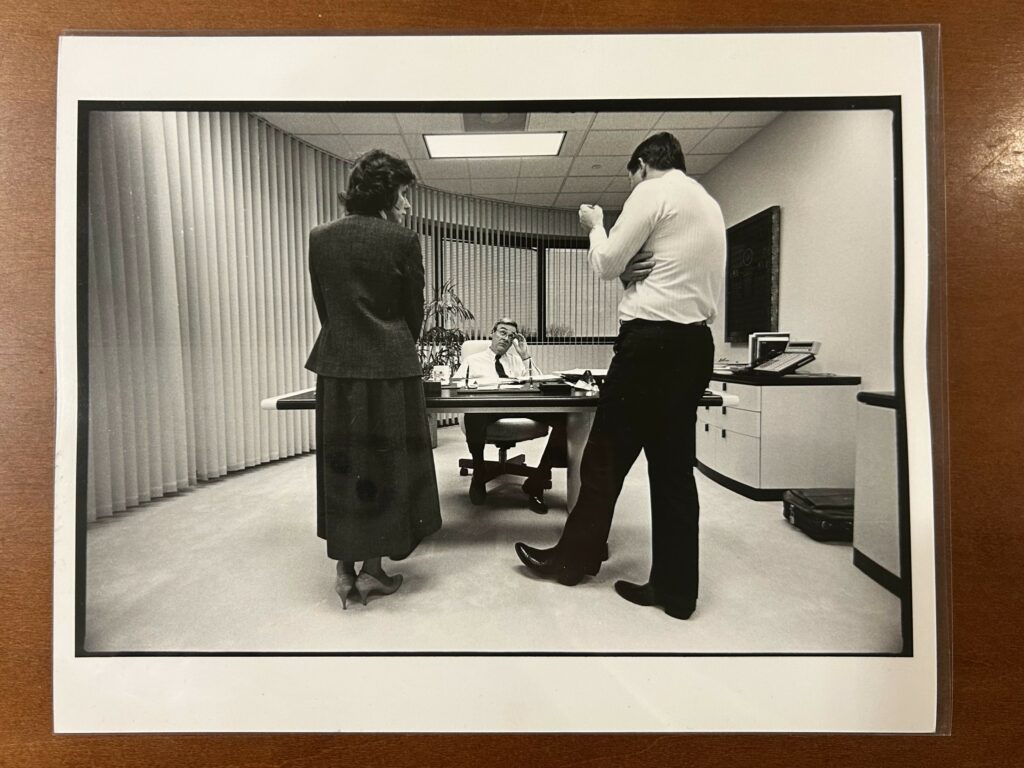By Erin Brogan, Journalism 27’, and Abbey Menza, Journalism 26’ for JOUR 4130 Gender, Race, and Class in Journalism and Mass Media with Victoria LaPoe, Spring 2025.
During the spring 2025 semester, the staff of the Mahn Center for Archives and Special Collections worked intensively with Victoria La Poe’s JOUR 4130 class, Gender, Race, and Class in Journalism and Mass Media. The students explored, selected, and researched materials from the collections, then worked in small groups to prepare presentations. The students had the option to then expand their research into a blog post like this one for their final project.
“The Testing of Dory Yochum” is a 1990 Life magazine article with photography by Lynn Johnson, an Ohio University alumna. The Lynn Johnson Collection, part of the Documentary Photography Archive at Ohio University Libraries, contains Johnson’s work on “The Testing of Dory Yochum.” The article covers Yochum, a pioneering corporate woman named Chief of Staff for the president of AT&T, and with Johnson’s photography, conveys Yochum’s life and how she balances the corporate world and motherhood. Yochum holding an executive position was quite the change to the male-dominant work environment, and she struggled fitting in with her male coworkers.
“It may not be me, and may not even be my generation, but women will have an equal place in the boardrooms. And the sooner the better for America” (Yochum).
Gender Responsive Policy
AT&T created Yochum’s position because of the Equal Employment Opportunity act of 1972– a gender-responsive policy aimed to address barriers and create representation for women. Until this point, few women were selected for or had opportunities for promotion. Gender roles at the time also meant that women were expected to leave their jobs if they elected to have families. While many companies had no issue following the executive order, others feared “the department would prove meddlesome and would inadvertently disclose corporate secrets, including salaries” (Kilbourne, 1990). Roughly 20 years after these policies were put in place, studies were finding little overlap between companies that have women among their top 5% of earners, and companies that won plaudits for advanced work-and-family policies. While both percentages were increasing, they appeared to often be mutually exclusive. Multiple hypotheses arose, even suggesting that women in healthy workplace environments became too comfortable and lacked the drive to pursue a higher career (Kilbourne). Robin Ely presented a contrasting theory suggesting malpractice from companies, “Some companies with good reputation for policies on paper are not so good in practice” (1990). She even goes on to say, “To be successful in a lot of companies, a woman has to conform to the image of someone who doesn’t have an outside life, who doesn’t have a family, and who doesn’t have any interests outside of work,” a theory that would be further explored with Nancy Reddy’s book The Good Mother Myth.
The Good Mother Myth and Work-Life Balance
The “Good Mother Myth” is a societal pressure and unrealistic belief that a “good mother” should always put the needs of her children before her own, she does not have a career outside of motherhood and she is endlessly patient and nurturing towards her children.
“The underlying problem is that the ‘good mother’ isn’t really a person. She’s a subject of capitalism, charged with optimizing every aspect of her kid’s childhood so she can produce good future workers and consumers” (Reddy).
The role of the “good mother” plays into work-life balance and the struggles that come with wanting a career outside of motherhood while also wanting to stay present as a mother. Dory Yochum touches on her own experiences with finding balance in her life as a working mother but concludes, “…this woman’s place is not at home” (p. 52). Reddy explains that the Good Mother Myth is “an exclusionary vision that harms us all.”

Discrimination and Stereotypes
Yochum faced a lot of discrimination during the hiring process and was often the object of harmful stereotypes. The Life article states, “As a master’s candidate at Rutgers she [Yochum] applied for a teaching post and was told that, though qualified, she wouldn’t get the job because ‘women don’t complete degrees.’” Women nationwide were facing the same challenges, with France native Anne Busquet stating, “It’s not always enough to have the right stuff; sometimes talent, intelligence, and drive aren’t enough to overcome an inhospitable environment” (Billard, 1990). Because of this discrimination, Yochum mentions uncertainty regarding the future of her career and whether she could climb the corporate ladder any further. In her obituary it is stated that she continued to defy her own expectations and serve as chief administrative officer for Palm Source Inc. in Palo Alto California after leaving AT&T.
Imagery and Framing
Lynn Johnson’s photos portray Yochum working side by side with coworkers and fostering a positive community that contrasted society’s idea of corporate women at the time.

The Coloring Book for Climbing Corporate Women focuses on a woman’s appearance and attitude towards male counterparts and pokes fun at harmful stereotypes that corporate women are “aggressive” and “bitchy.” The book utilizes satire and childlike cartoons to portray the very serious issues women face every day. Yochum, for instance, shares she couldn’t express the same emotions as the men in the office, stating “you get in trouble when you get mad.” It is important to consider distribution of images regarding framework because of patterns that contribute to incorrect narratives and ideologies.

The Evolution of Women in the Workplace
In order to highlight the improvements for working mothers in today’s society, we chose to interview Candice Rios Wenmoth, an Assistant Professor in the School of Communication Studies. Rios Wenmoth was an ideal candidate to interview as she juggles her professional career with raising two children. While Rios Wenmoth describes her career journey as “nontraditional,” she explains her successes and struggles with motherhood. “More than any career aspiration, I always wanted to be a mom,” she said. Rios Wenmoth describes her motherhood journey as full of support from her mother, husband and fellow Ohio University staff members. She also explains how her role as a professor allows flexibility in spending time with her children. “I have flexibility that I would say the average corporate worker does not have,” she said.
Navigating motherhood with a professional career requires switching your mindset and demeanor back and forth. Rios Wenmoth describes her experience with this, “I didn’t anticipate how hard it would be to shift my brain space. It requires such different things of you to be soft and gentle and present with your kids, and in my career field, that energy has to change,” she said. “Shifting back and forth out of those roles is exhausting.”
While Dory Yochum’s experience balancing motherhood and corporate life lacked support, Candice Rios Wenmoth’s journey as a mother reflects the progress and improved resources available to mothers today. Although many support systems have evolved over time for women like Rios Wenmoth, every individual’s experience varies depending on the field in which they work.

Feminist Standpoint Theory
Yochum’s story is a part of feminist standpoint theory, which feminist scholar Sandra Harding presented in the early 1970s. The theory states that people from marginalized groups have unique perspectives and opinions about society due to their social positions. It argues that knowledge is shaped by experience, and people in marginalized communities, such as women, may see power struggles more clearly due to their personal experiences.
As mentioned in Sandra Harding’s research article, “Standpoint Theories: Productively Controversial,” “Standpoint theory provides a logic of research that focuses attention on problems that are deeply disturbing to anyone reflecting on contemporary challenges to Western thought and practice, and yet insoluble within the philosophical, political, and theoretical legacies that they provide” (p. 198).
Storytelling
Stories like Yochum’s are important to share because they are often the best way to promote the continuation of breaking gender-norms. At the time the Life article was written, many women were afraid of breaking the glass ceiling and being named a bad mother for pursuing a career. Yochum put many of these fears to rest and continues to be a role model for future generations. After her death, tens of coworkers came forward sharing the impact her leadership had on their life. Robert Holland, an AT&T communications employee under Yochum, stated,
“Dory believed in communication, and as a result, she gave this young communicator a lot of room to be creative and to try new things. She valued my perspective and my role, which greatly boosted my self-confidence at a crucial time in my career, just a few years after leaving news journalism for the corporate world” (2011).
Limitations
Intersectionality, a term coined by Black feminist scholar, Kimberlé Crenshaw, explains the intersection of race, class and gender and how it effects one’s place in society. Intersectionality helps recognize the overlapping of identities and how some people may benefit in one area while facing barriers in another.
In the case of Dory Yochum, intersectionality played a part in how she was treated in the workplace. As a white woman, she experienced certain advantages over women of color, thus concluding that her experience cannot be assumed for women of a different background.
Our interview compares an academic professor’s experiences with those of a corporate woman. Future research would include finding current examples of corporate women to compare to the lives of those we looked at, including Yochum.
Conclusion
Yochum’s story was one of few success stories about corporate women at the time. Johnson’s photography changed the narrative for many corporate women and spread positive imagery to inspire future generations. Photos display similar scenes to that of the coloring book, but with the perspective of a collaborative working environment. Yochum fought in a male-dominated space to prove that women deserve to be in corporate environments. Today, women are continuing the fight against the glass ceiling, using Yochum’s story as inspiration. Yochum stated, “We all have to keep bouncing against the glass ceiling until it breaks.”
Sources
Babic A, Hansez I. The Glass Ceiling for Women Managers: Antecedents and Consequences for Work-Family Interface and Well-Being at Work. Front Psychol. 2021 Mar 9;12:618250. doi: 10.3389/fpsyg.2021.618250. PMID: 33767646; PMCID: PMC7985459.
Billard, Mary. “Women on the Verge of Being CEO.” Business Magazine, Apr. 1990.
Brimi, Marjorie, et al. The Coloring Book for Climbing Corporate Women. Once and Future Press, 1980.
Dobrzynski, Judith H. “Some Sober News for Women Working Up the Corporate Ladder.” The New York Times, 6 Nov. 1996.
Doreen Yochum Obituary (2010) – Newark, NJ – the Star-Ledger, obits.nj.com/us/obituaries/starledger/name/doreen-yochum-obituary?pid=146989382. Accessed 23 Apr. 2025.
Journal of Family Issues. Dec. 1990. (11) 4.
Hardacre SL, Subašić E. Whose Issue Is It Anyway? The Effects of Leader Gender and Equality Message Framing on Men’s and Women’s Mobilization Toward Workplace Gender Equality. Front Psychol. 2018 Dec 11;9:2497. doi: 10.3389/fpsyg.2018.02497. PMID: 30618930; PMCID: PMC6298257.
Harding, Sandra. “Standpoint theories: Productively controversial.” Hypatia, vol. 24, no. 4, 2009, pp. 192–200, https://doi.org/10.1111/j.1527-2001.2009.01067.x.
Kilbourne, Peter. “Labor Department Wants to Take on Job Bias in the Executive Suite.” The New York Times, 30 July 1990.
Lynn Johnson Collection. Mahn Center for Archives & Special Collections, Ohio University Libraries, Athens, Ohio.
Reddy, Nancy, and Sara Sheckells. The Good Mother Myth Unlearning Our Bad Ideas about How to Be a Good Mom. Macmillan Audio, 2025.
Rios Wenmoth, Candice, Personal communication (personal interview). 8 April 2025.